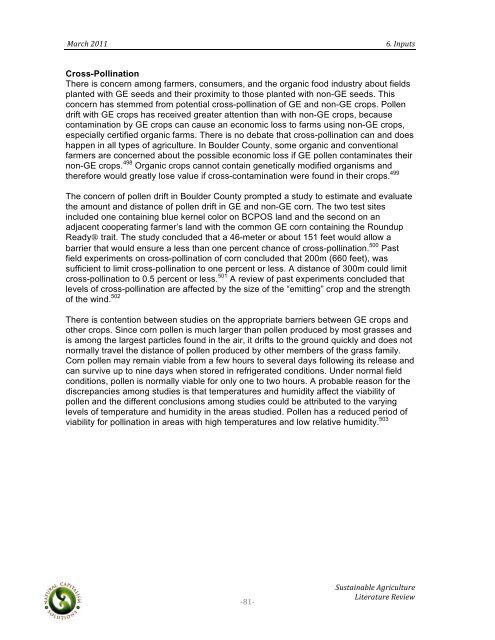Sustainable Agriculture Literature Review - Boulder County
Sustainable Agriculture Literature Review - Boulder County
Sustainable Agriculture Literature Review - Boulder County
Create successful ePaper yourself
Turn your PDF publications into a flip-book with our unique Google optimized e-Paper software.
! ! !!<br />
"#$%&!'())!! !!!!!!!!!!!!!!!!!!!!!!!!!!!!!!!!!!!!!!!!!!!!!!!!!!!!!!!!!!!!!!!!!!!!!!!!!!!!!!!!!=+!>5?324!<br />
Cross-Pollination<br />
There is concern among farmers, consumers, and the organic food industry about fields<br />
planted with GE seeds and their proximity to those planted with non-GE seeds. This<br />
concern has stemmed from potential cross-pollination of GE and non-GE crops. Pollen<br />
drift with GE crops has received greater attention than with non-GE crops, because<br />
contamination by GE crops can cause an economic loss to farms using non-GE crops,<br />
especially certified organic farms. There is no debate that cross-pollination can and does<br />
happen in all types of agriculture. In <strong>Boulder</strong> <strong>County</strong>, some organic and conventional<br />
farmers are concerned about the possible economic loss if GE pollen contaminates their<br />
non-GE crops. 498 Organic crops cannot contain genetically modified organisms and<br />
therefore would greatly lose value if cross-contamination were found in their crops. 499<br />
The concern of pollen drift in <strong>Boulder</strong> <strong>County</strong> prompted a study to estimate and evaluate<br />
the amount and distance of pollen drift in GE and non-GE corn. The two test sites<br />
included one containing blue kernel color on BCPOS land and the second on an<br />
adjacent cooperating farmer’s land with the common GE corn containing the Roundup<br />
Ready" trait. The study concluded that a 46-meter or about 151 feet would allow a<br />
barrier that would ensure a less than one percent chance of cross-pollination. 500 Past<br />
field experiments on cross-pollination of corn concluded that 200m (660 feet), was<br />
sufficient to limit cross-pollination to one percent or less. A distance of 300m could limit<br />
cross-pollination to 0.5 percent or less. 501 A review of past experiments concluded that<br />
levels of cross-pollination are affected by the size of the “emitting” crop and the strength<br />
of the wind. 502<br />
There is contention between studies on the appropriate barriers between GE crops and<br />
other crops. Since corn pollen is much larger than pollen produced by most grasses and<br />
is among the largest particles found in the air, it drifts to the ground quickly and does not<br />
normally travel the distance of pollen produced by other members of the grass family.<br />
Corn pollen may remain viable from a few hours to several days following its release and<br />
can survive up to nine days when stored in refrigerated conditions. Under normal field<br />
conditions, pollen is normally viable for only one to two hours. A probable reason for the<br />
discrepancies among studies is that temperatures and humidity affect the viability of<br />
pollen and the different conclusions among studies could be attributed to the varying<br />
levels of temperature and humidity in the areas studied. Pollen has a reduced period of<br />
viability for pollination in areas with high temperatures and low relative humidity. 503<br />
!<br />
",'"<br />
!,342#.5#6/1!78$.%3/23$1!<br />
9.21$#23$1!:1;.1
















